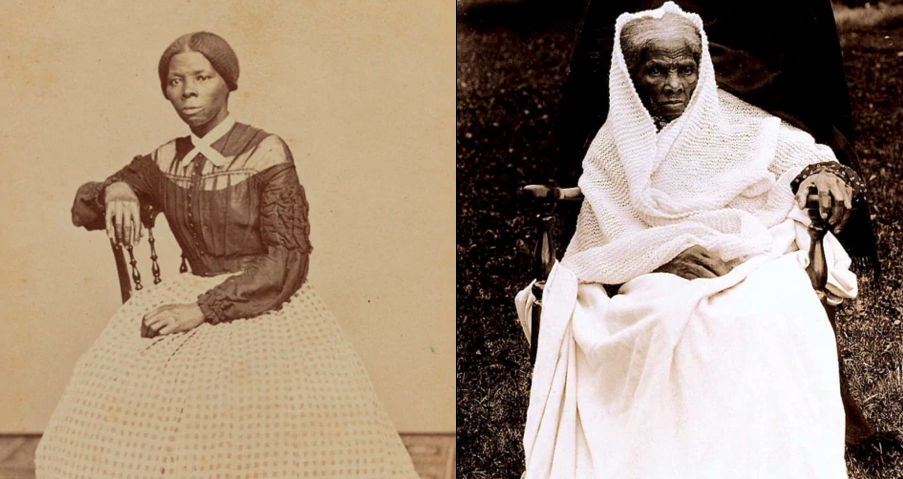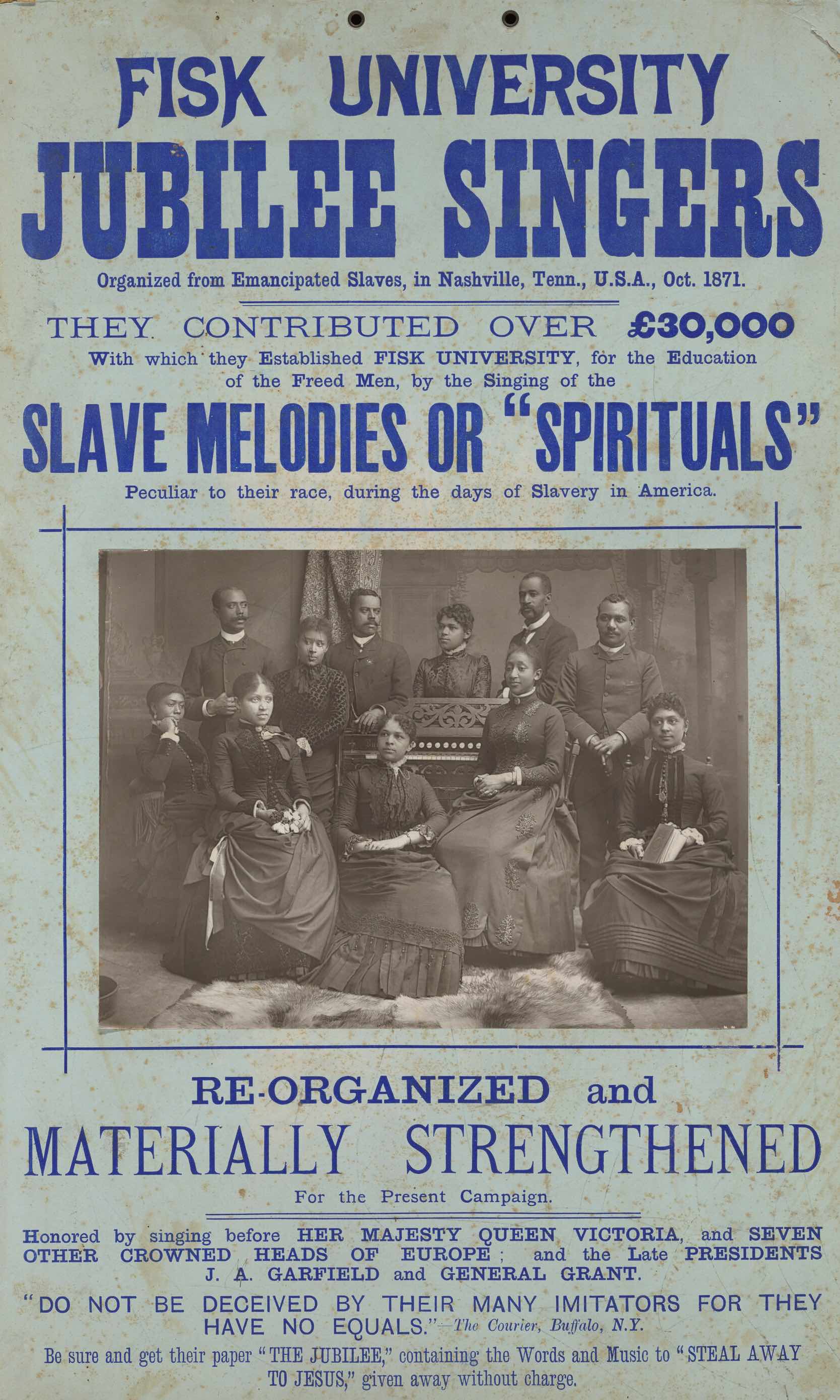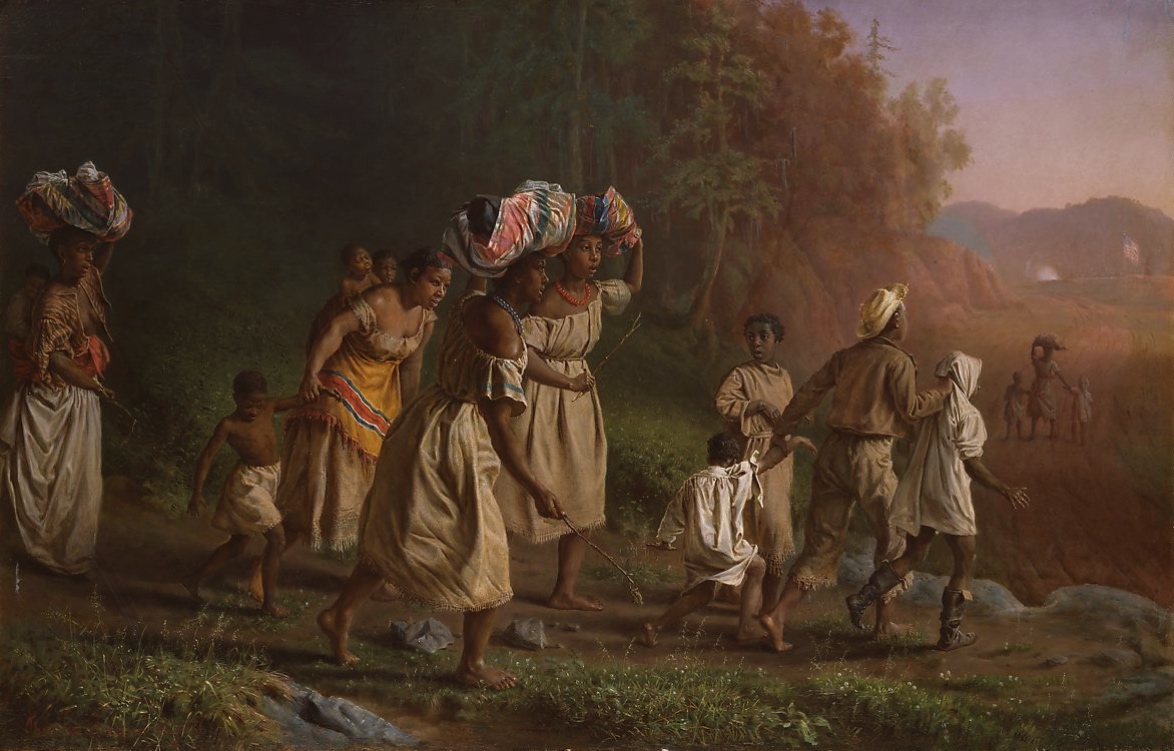
Kaufmann, Theodor. On to Liberty (inset). 1867. The Met, New York. [o]
Of the ripple effects associated with slavery, one of the most enduring and impactful is the rich musical tradition of songs and music of protest. From anti-slavery spirituals to blues, jazz and rap, the evolution of African American protest music is a multi-layered and fascinating journey.
During the slavery era when there was a systematic attempt to wipe out traditional African culture, slaves were not allowed to speak their language and were denied the practice of traditional religious rituals —the usual control efforts of a colonizing power. But the efforts only succeeded in pushing these cultural elements underground. Slaves would meet in secret in the bush to carry out traditional religious practices in their native languages, and these were imbued with African-inspired dance rhythms and vocal techniques, including the “ring shout”, a circular dance typically consisting of the following four ingredients:
1. Antiphony (alternating sound effects), popularly termed “call and response”. The ring shout typically used person-to-group antiphony: a caller shouting out a line followed by the group echoing it back. This essentially blurred the distinction between audience and performer, a radical departure from Western musical structure.
2. Improvisation. A traditional African practice used in singing and dancing, made easier because, apart from makeshift percussion instruments, there was traditionally no musical accompaniment limiting the creativity. Creativity was additionally enhanced because the songs were not written down, and hence there was no visible, standard version of a song that determined its content.
3. An emphasis on ‘blue notes’ was a key pitch characteristic: flattening the pitch of certain notes. These undoubtedly emerged because of the desire of slaves to have their own distinct musical expression of lamenting the dehumanizing conditions of slavery.
4. A polyrhythmic beat (two or more rhythms produced simultaneously), usually effected by hand clapping and a variety of simple percussion instruments.
These songs were characterized by spontaneity and improvisation that merged the two distinct cultures into a unique musical genre – the spiritual.
THE CODED LANGUAGE OF SPIRITUALS
Over time, ring shouts brought in biblical imagery that slaves learned from their white masters and itinerant preachers. The slaves were fascinated by certain old testament characters and stories that began appearing in their songs. Of particular interest were those stories containing elements of escape from oppression facilitated by a benevolent if not vengeful god, stories like Moses and the Red Sea and Daniel in the Lion's den. These songs were characterized by spontaneity and improvisation that merged the two distinct cultures into a unique musical genre – the spiritual. The term derives from the idea that the third element in the triune Christian Godhead, the holy spirit, would enter into people's consciousness and be manifested in passionate singing and dancing. So a spiritual became that musical manifestation of the holy spirit entering and captivating a person: Ephesian V:9 — “Singing and making melody in your heart to the Lord.”
Many of these songs contained elements of resistance to slavery and occasionally allusions to actual escape from bondage. These references, however, because of the omnipresence of slave-owners and plantation managers, were typically hidden in the songs, resulting in what has been termed the “coded spiritual.” To quote from Dorian Linskey’s seminal book, 33 Revolutions Per Minute: A History of Protest Songs, from Billie Holiday to Green Day, (2011), “Spirituals had been the protest songs that dared not speak their name. (41)” However, he then goes on to assert that coded messages would have been obvious to those within earshot: “You have to wonder . . . how even the dimmest slave drivers failed to notice their workers fondness for particular Bible stories, e.g., Daniel delivered from the Lions Den; Moses leading his people out of Egypt.” Yet Linskey fails to recognize, apart from the coded element, that the meanings of the songs were difficult for whites to decipher because they were sung in Gullah.
Gullah is an English-based Creole dialect spoken primarily by African Americans living in the Georgia Sea Islands of South Carolina and Georgia. (The term is said to derive from Angola, the country of origin of many Georgia Sea Islanders.) The isolation from the mainland of the islands of St. Helena and Sapelo was a key ingredient for the flourishing of Gullah language and music. It was also given impetus by the necessity of a common language among slaves of disparate countries and tribal origins.
William Allen, one of the authors of the great collection of spirituals, Slave Songs of the United States (1867), confirms the important role Gullah played in obscuring communication amongst slaves: “A stranger, upon first hearing these people talk, especially if there is a group of them in animated conversation, can hardly understand them better than if they spoke a foreign language, and might, indeed, easily suppose this to be the case. . . After six months’ residence among them, there were scholars in my school, among the most constant in attendance, whom I could not understand at all, unless they happened to speak very slowly.”
So why do I use the term “protest song” to refer to spirituals? First, slaves managed to create in these songs an isomorphism between their situation and the situation in which oppressed people in the Bible found themselves. They strongly identified with the Hebrew slaves and saw themselves as their contemporary counterparts. Like Daniel, they saw themselves tossed into the lions’ den, and later, ultimately to receive freedom. The biblical route to freedom was often via crossing bodies of water, therefore many spirituals play upon the strong and uplifting references to the crossing of the Red Sea and the Jordan River. Both of these were codes for the Ohio River, which was the major underground railroad escape route.

Harriet Tubman (1822-1913) was an American abolitionist and political activist who was born into slavery. After escaping she made thirteen missions to 70 enslaved people. 1: [o], 2: [o]
A second ingredient involves the coded techniques referred to earlier. Spirituals often contained double or triple meanings so that on the surface, by alluding to Bible stories, they indicated they were adopting the Christian beliefs of their masters. However true this was, beneath the explicit faith-based references to Bible stories and characters were implicit messages about resistance to slavery and possible escape. This was given credence by the inimitable Harriet Tubman who brought many slaves to freedom through the underground railroad (from Harriet, the Moses of Her People, by Sarah H. Bradford, 1886.)
Slaves must not be seen talking together, and so it came about that their communication was often made by singing, and the words of their familiar hymns, telling of the heavenly journey, and the land of Canaan, while they did not attract the attention of the masters, conveyed to their brethren and sisters in bondage something more than met the ear.
This was reinforced by escaped slave and abolitionist Frederick Douglass, in My Bondage and My Freedom (1855). who suggests the conflation of ‘Canaan’ and Canada
A keen observer might have detected in our repeated singing of 'O Canaan, sweet Canaan, I am bound for the land of Canaan’, something more than a hope of reaching heaven. We meant to reach the north – and the north was our Canaan. I thought I heard them say, ‘There were lions in the way,/ I don’t expect to stay/ Much longer here.’ It was a favorite air and had a double meaning. In the lips of some, it meant the expectation of a speedy summons to a world of spirits; but in the lips of our company, it simply meant a speedy pilgrimage toward a free state, and deliverance from all the evils and dangers of slavery.
MICHAEL ROW THE BOAT ASHORE
A spiritual many of us have enjoyed around campfires, but were oblivious to its coded themes, is “Michael Row the Boat Ashore.” This was a work song sung by slaves rowing boats in the Georgia Sea Islands. Such singing, Raber notes, “was tolerated on the plantations (and even encouraged), as slave masters considered it a method to increase productivity in their plantation workers, coordinating the rhythm of their physical work.” (Raber, Rebecca Lynn. Conducting the Coded Message Songs of Slavery: Context, Connotation, and Performance Preparation. 2018, p. 11) The campfire song we are familiar with bears little resemblance to the original version presented below; the song was greatly modified by Pete Seeger and Tony Saletan who eliminated some verses, rewrote others, and removed its Gullah dialect. In doing this, I believe they were seeking a wider audience, but it’s also possible they thought singing in the original dialect was an inappropriate cultural appropriation of the song.

The Fisk Jubilee Singers were an a cappella ensemble of students at Fisk University. Their early repertoire consisted mostly of traditional spirituals, but included some songs by Stephen Foster. [o]
The Michael in the song likely refers to the archangel Michael, called on to guide the rowers safely across the Jordan River to the traditional holy lands of Judea and Sumaria. But reaching these lands is also about escaping from slavery into the free states north of the Ohio River, and so many spirituals contained coded messages referring to it. For instance, the starred lines indicate the escape-related messages extant in the song ("Michael Row The Boat Ashore," from Allen, Ware and Garrison, Slave Songs of the United States, 1867):
Michael row de boat ashore, Hallelujah!
Michael boat a gospel boat, Hallelujah!
*I wonder where my mudder deh,
This line asks whether the singer’s mother made it to freedom. Did she cross the Ohio?
See my mudder on de rock gwine home.
On de rock gwine home in Jesus' name.
Michael boat a music boat.
Gabriel blow de trumpet horn.
*O you mind your boastin' talk.
Boastin' talk will sink your soul.
*Brudder, lend a helpin' hand.
Sister, help for trim dat boat.

Kaufmann, Theodor. On to Liberty. 1867. The Met, New York. [o]
*O you mind your boastin' talk” admonishes those considering escaping not to talk about their plans for fear that 'boasting talk' would undermine escape efforts. The allusion to getting help from “brudder” and “sister” reinforces the idea that escape is a collective effort.
Jordan stream is deep and wide.
Jesus stand on t' oder side.
* I wonder if my maussa deh.
My fader gone to unknown land.
O de Lord he plant his garden deh.
He raise de fruit for you to eat.
He dat eat shall neber die.
* When de riber overflow.
O poor sinner, how you land?
Riber run and darkness comin'.
Sinner row to save your soul.
The dreadful possibility of being sent back to bondage is alluded to in the line "I wonder if my maussa deh." Will the runaway’s master be waiting on the other side of the Ohio to reclaim his “property”? This possibility was given official legal status in 1850 with the passage of the Fugitive Slave Act. With “When de riber overflow” there is the reference to the difficulty of landing when the river is high, sending the message that one should not arrive at the Ohio River during the spring. Rather, it is wisest to begin the journey north in the Spring and arrive when the water level has abated.
A rare exception to the coded spiritual is 'Many Thousands Gone.' This is a commentary on the evils of slavery, a direct indictment of its brutality. The meaning is clear and explicit. It defiantly states: “No more auction block for me, no more pint o’ salt for me, no more driver’s lash for me.” (Pint o’ salt referred to the amount of the monthly salt ration each slave received.)
There are at least two hypotheses for why the meaning was not hidden, like in most slavery spirituals. First, there might have been agreement that the song was not to be sung in front of white overseers or plantation owners; that is, that it was to be limited to secret locations such as those in bush meetings. A second possibility is that the song’s collectors, Ware, Garrison and Allen, heard it sung by freed slaves, who were no longer constrained by possible repercussions. In either case, it is a poignant testimony to the resilience of those who suffered under slavery. No one does it justice like civil rights activist and consummate performer Paul Robeson. ≈ç
Read Part 2 of this two-part essay.

STEPHEN RICHER is a Professor Emeritus at Carleton University, where he was head of the Sociology and Anthropology Department. He has been a folk and protest singer since his teens. He now teaches courses on the history of protest music at Carleton’s Institute for Lifelong Learning Program. He lives in Ottawa. Stephen's lecture on the life and influence of Pete Seeger can be seen here.

Comments
Thank you, Steve. This is a…
This is a wonderful posting with wonderful photos. Thank you, Steve.
Hey, Stefano, this was…
Hey, Stefano, this was really interesting and well-done. Great to see you still you passionate and intellectually involved! One question/quibble re: this observation:
“In doing this, I believe they were seeking a wider audience, but it’s also possible they thought singing in the original dialect was an inappropriate cultural appropriation of the song.”
I wonder if your hypothesis of ‘cultural appropriation’ is retrospectively attributing a (recent) concept that was unknown — consciously or unconsciously at that time. Thoughts?
Paul: This is an excellent…
This is an excellent…
Paul:
This is an excellent point. The term cultural appropriation did not appear until the 80's, so of course Seeger was unaware of it at the time. From what I know about him, however, I believe he would have been very sensitive to the issue, and would have experienced the dilemma., no matter what term he was using to think about it.
Thanks so much for writing…
Thanks so much for writing this. As always, I learned something from reading it, and thoroughly dug the graphics and video as well. It's interesting to think about coded instructions in spirituals as predecessors to double-entendres in blues ...
Stephen once again invites…
Stephen once again invites us to revisit songs and melodies we have been singing around our campfires since we were kids...and to look at these musical creations through a clearer lens, to better understand the pain, suffering and hope they translated.
Absolutely fascinating!…
Absolutely fascinating! Especially the musicological insights into African musical traditions. Thank you, Steve. But so painful too to be reminded yet again of man's inhumanity to man and the legacy of slavery that still pervades contemporary American and Western culture. Looking forward to Part 2 . . . TBK
Add new comment